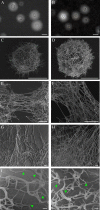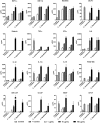The environmental yeast Cryptococcus liquefaciens produces capsular and secreted polysaccharides with similar pathogenic properties to those of C. neoformans
- PMID: 28440301
- PMCID: PMC5404263
- DOI: 10.1038/srep46768
The environmental yeast Cryptococcus liquefaciens produces capsular and secreted polysaccharides with similar pathogenic properties to those of C. neoformans
Abstract
Invasive fungal infections, including cryptococcosis, are a growing threat to immunocompromised patients. Although Cryptococcus neoformans and Cryptococcus gattii are the main agents of human cryptococcosis, opportunistic infections by environmental species, such as C. liquefaciens, have been observed recently. The main Cryptococcus virulence factor is the production and secretion of polysaccharides (PS). Previously, we showed that both species produce PS of similar composition. Here, we examined the ultrastructure and biological activity of capsular and secreted PS from C. liquefaciens, and yeast pathogenicity to an invertebrate host, in comparison with C. neoformans. Ultrastructural analysis by high-resolution microscopy showed that both species produce large and complex capsules. PS from both species had indistinguishable effects on phagocytosis levels, NO production and the secretion of a variety of immune mediators. Challenge with C. liquefaciens or C. neoformans led to complete lethality of G. mellonella larvae. Treatment with C. liquefaciens PS could not protect mice against infection with C. neoformans. We conclude that polysaccharides of the environmental yeast C. liquefaciens have strikingly similar ultrastructural and biological properties to those of C. neoformans, highlighting the importance of monitoring the emergence of new fungal pathogens for which thermotolerance may be an important transitional step towards pathogenesis in humans.
Conflict of interest statement
The authors declare no competing financial interests.
Figures






References
-
- Martin G. S., Mannino D. M., Eaton S. & Moss M. The epidemiology of sepsis in the United States from 1979 through 2000. N. Engl. J. Med. 348, 1546–54 (2003). - PubMed
-
- Holzheimer R. G. & Dralle H. Management of mycoses in surgical patients – review of the literature. Eur. J. Med. Res. 7, 200–26 (2002). - PubMed
-
- Peres-Bota D. Rodriguez-Villalobos H., Dimopoulos G., Melot C. & Vincent J. L. Potential risk factors for infection with Candida spp. in critically ill patients. Clin. Microbiol. Infect. 10, 550–5 (2004). - PubMed
-
- Perlroth J., Choi B. & Spellberg B. Nosocomial fungal infections: epidemiology, diagnosis, and treatment. Med. Mycol. 45, 321–46 (2007). - PubMed
-
- Meersseman W. & Van Wijngaerden E. Invasive aspergillosis in the ICU: an emerging disease. Intensive Care Med. 33, 1679–81 (2007). - PubMed
Publication types
MeSH terms
Substances
LinkOut - more resources
Full Text Sources
Other Literature Sources

